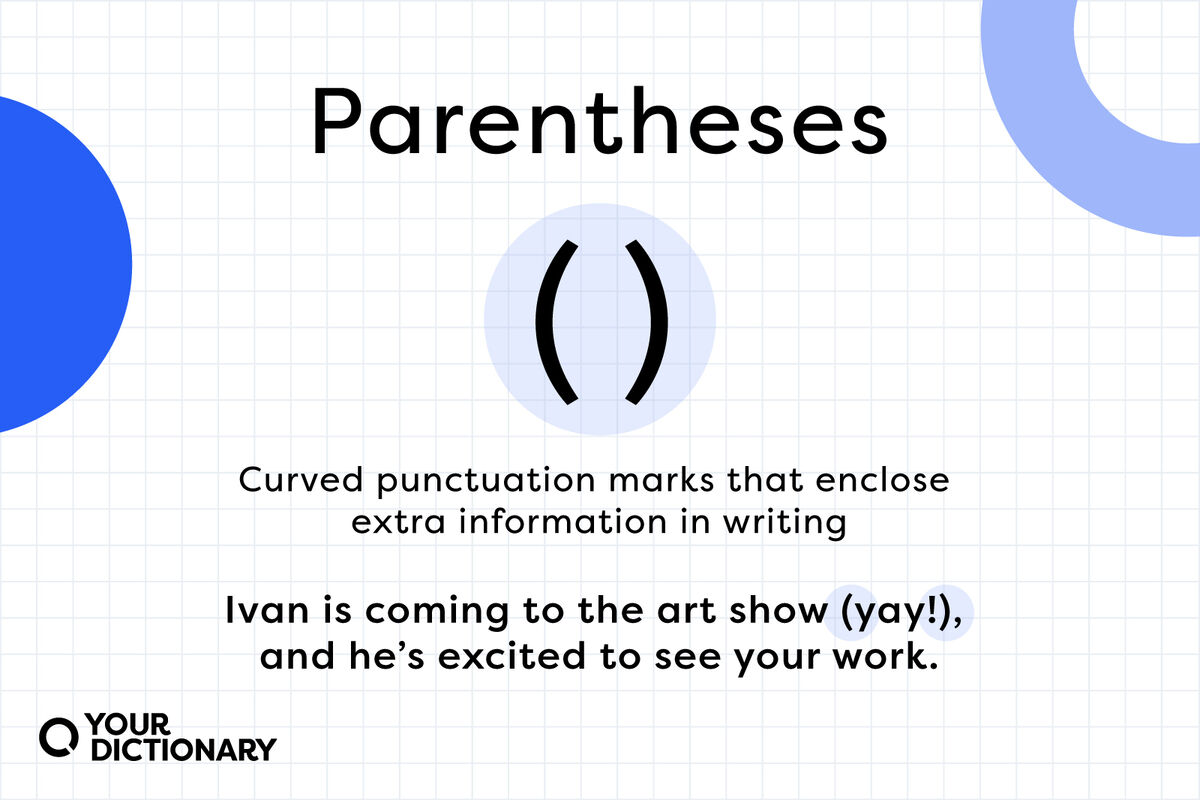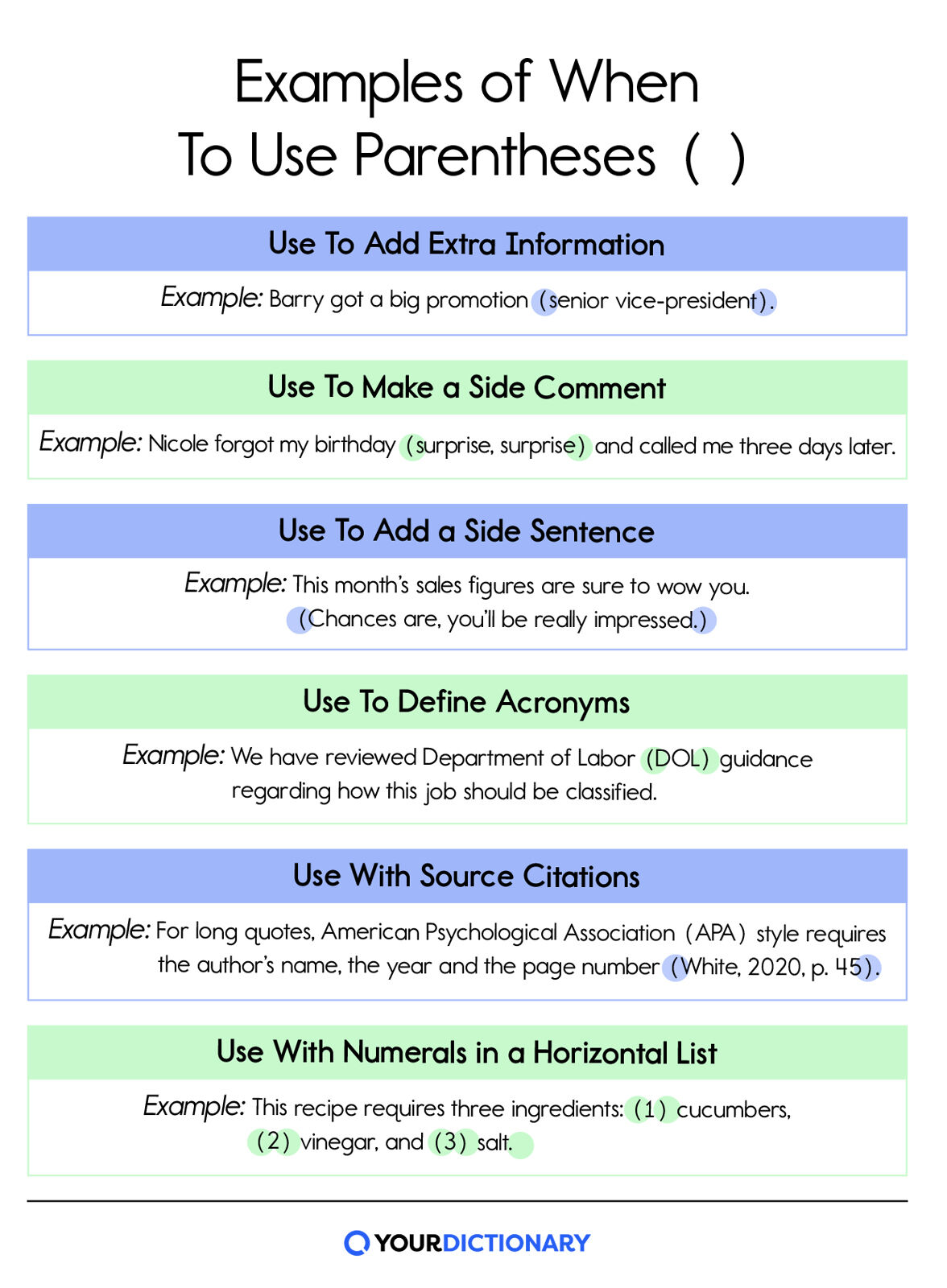
Parentheses are curved punctuation marks that enclose text (like this). They always function in pairs, with each one curving away from the text inside it.
The word parentheses comes from the Greek parentithenai, meaning “insertion” or “to put beside.” It’s what parentheses do: They insert text in writing, beside the rest of the sentence.
"Parentheses" vs. "Parenthesis"
Parenthesis is the singular form of parentheses. While parentheses refers to a pair of parentheses, parenthesis refers to only one of them.
The majority of the time, parentheses is the word you want (since you use two at a time).
Sometimes, you’ll see the word parenthesis referring to the word or words inside the parentheses itself, but parentheses always refers to the pair of punctuation marks.
Fast Fact
Is the word parentheses too long? You can use parens instead; it’s an abbreviated form of parentheses.
If you need the singular version, paren can stand in for parenthesis.
Examples of Parentheses in a Sentence
You’ll find parentheses when a writer wants to add additional information into their writing.
Parentheses can enclose a single word, a sentence fragment, a complete sentence, or even multiple complete sentences.
- Single word - Ivan is coming to the art show (yay!), and he’s excited to see your work.
- Fragment - Ivan is coming to the art show (or so he says), and he’s excited to see your work.
- Full sentence - Ivan is coming to the art show, and he’s excited to see your work. (Will he be on time, though?)
- Multiple sentences - Ivan is coming to the art show, and he’s excited to see your work. (Will he be on time, though? He’s usually at least 30 minutes late, no matter what.)
When To Use Parentheses
You have several ways to use parentheses in your writing — some of which are required, and some of which are more for style.
While some parentheses rules are strict, there’s a bit of wiggle room inside your sentences when you really want to add something.

Use Parentheses To Add Extra Information
The most common way to use parentheses is to insert extra information in your sentence.
Also known as non-essential clauses, these parenthetical expressions should be helpful but unnecessary. The sentence should still make sense without the extra information, but it clarifies your meaning.
- I am making dinner (pot roast with potatoes and carrots) in the slow cooker.
- She always brings her dog (the little one that barks at me) when she comes to visit.
- Barry got a big promotion (senior vice-president).
Use Parentheses To Make A Side Comment
You can also put parentheses around a comment that reveals how the speaker really feels about something.
These comments help your tone and voice, but aren’t recommended for formal writing.
- Mike burned the casserole (yet again).
- I told the neighbor I’d watch his parrots (even though I really didn’t want to).
- Nicole forgot my birthday (surprise, surprise) and called me three days later.
Use Parentheses To Add a Side Sentence
If a side comment isn’t enough space for you, you can finish your sentence and add a parenthetical statement afterward.
They’re not relevant enough to be their own sentences outside the parentheses, but interesting enough to be included after the main sentence.
- This month’s sales figures are noteworthy. (Chances are, you’ll be really impressed.)
- Sure, I can meet you on Tuesday at 1 p.m. (I wonder if she’ll really show up this time.)
Use Parentheses To Define Acronyms
When you refer to something that commonly goes by an acronym or initialism, write it out fully and use parentheses to show its shortened version.
You only need to do this the first time it appears in your writing; you can just use the acronym or initialism afterward.
- We have reviewed Department of Labor (DOL) guidance regarding how this job should be classified. Until the DOL rules change, this is how we’ll classify it.
- The Federal Emergency Management Agency (FEMA) has allocated funds to help people recover from the disaster. A FEMA representative will visit soon.
Use Parentheses With Source Citations
In academic writing, you need to use parentheses for in-text citations.
This should be done in a manner consistent with the particular style guide required by your instructor or the scholarly journal or conference to which you plan to submit your work.
- For long quotes, American Psychological Association (APA) style requires the author’s name, the year and the page number (White, 2020, p. 45).
- In Modern Language Association (MLA) style, long quotes are treated differently. The author’s name and page number go in parentheses, with no comma (White 45).
Use Parentheses With Numerals
When including the equivalent of a numbered list within a sentence, you are creating what is referred to as a horizontal (across) list.
With this type of numbered list, you should put parentheses around each numeral.
- This recipe requires three ingredients: (1) cucumbers, (2) vinegar, and (3) salt.
- I will be visiting three different Alabama cities, in order from north to south: (1) Huntsville, (2) Birmingham, and (2) Montgomery.
Does Punctuation Go Inside or Outside Parentheses?
Like quotation marks, parentheses tend to end up with some extra punctuation, especially when they’re at the end of a sentence. So where does that punctuation go?
Periods, commas, exclamation points, and question marks that belong to the outside sentence always go outside the parentheses.
- Amanda got a great deal on a used camper (just $500).
- We left early in the morning (4:00), but forgot to eat breakfast.
- I can’t believe she’s telling the truth (she never does)!
- Will you sing me a song (something I haven’t heard before)?
If the period, exclamation point, or question mark belongs to the parenthetical expression, it goes inside the parentheses. (Commas can’t end a sentence.)
Parenthetical expressions may need their own punctuation because they’re full sentences, or because they have a different tone than the rest of the sentence. (Note that the punctuation that belongs to the sentence still goes outside the parentheses.)
- Paul asked me out (even though he’s still dating Naomi!).
- Ian bought me earrings (possibly vintage?) and flowers for our anniversary.
When To Use Brackets Instead
Brackets are square versions of parentheses — they also enclose text inside a sentence. But they function a little differently than their curved counterparts.
Use brackets instead of parentheses when:
- adding a parenthetical statement within a parenthetical statement
- adding a missing word to a quote
- adding [sic] to a quote
- translating a quote from another language
Parentheses in Emoticons and Emoji
If you remember texting before the days of the emoji keyboard, you’re probably quite familiar with using parentheses in various emoticons.
A parenthesis often functions as the bottom half of an emoticon smiley face :), or a pair of parentheses can be the sides of an exasperated face (-_-).
While these uses may feel outdated, many text programs will convert your typed emoticons into more modern emoji, so don’t forget about all those cool faces yet (we’re looking at you, clown emotion: <8-) )
Tips for Using Parentheses
Now that you know how these versatile punctuation marks work, use these tips to decide when you need them.
- Think of parenthetical expressions as a friend whispering in your ear during a movie. Can you still understand the movie without your friend’s whispers?
- Double check that you’re using two parentheses, not just one. It’s a common grammar error to add an opening parenthesis but then forget the closing parenthesis.
- Don’t use too many parentheses in your writing. (Even if you want to.) (They can get annoying.) (But one per page is okay!)
- If you like to use a lot of parentheses, try substituting them with commas or em dashes. They’ll serve the same purpose and give you even more sentence variety.